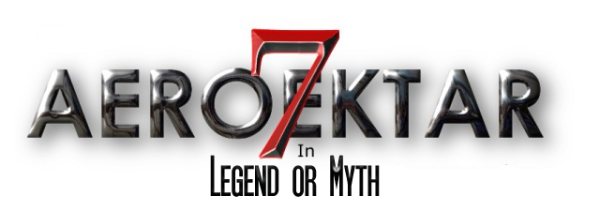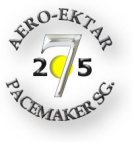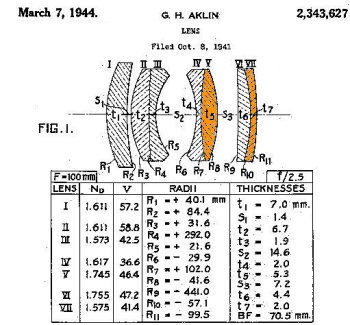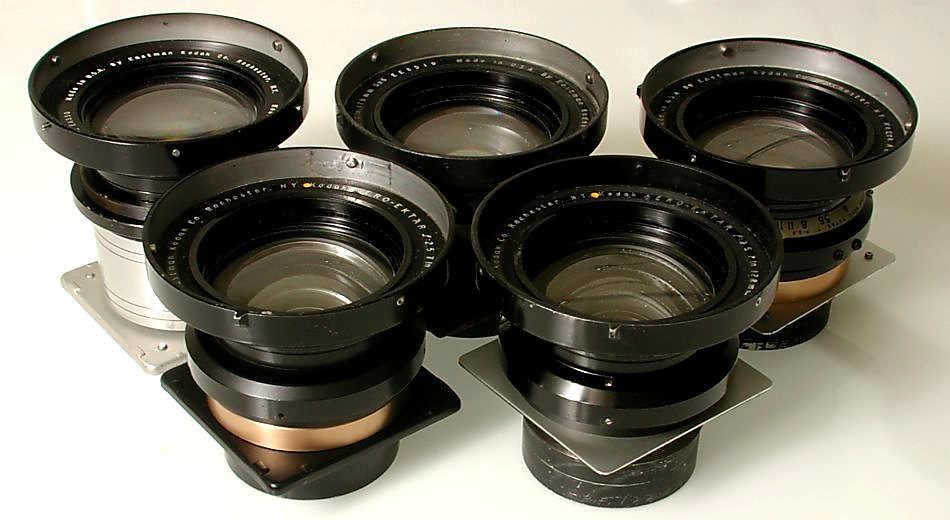
One man's junk is another man's treasure!
|

 |

|
Kodak Aero-Ektar f2.5 7in (178mm) 5x5 EE ****,
Made in USA by Eastman Kodak Co., Rochester, N.Y.
Patent Pending 1941 - Patent issued 1944
According the prescription USP 2,343,627 (Aklin/Kodak) it is a seven element Biotar type.
It has 6 stops: 2.5, 4.0, 5.6, 8.0, 11.0, 16.0
The Aero-Ektars are lenses for aerial reconnaissance photography made by Kodak.
Most were made for War World II. For their time, the Aero-Ektars were very advanced technology with a new optical design and use of the latest optical cement, coatings and high-tech optical glasses.
Today their most notable feature is their fast starting aperture of f 2.5 .
Also the AE is quite famous for its special optical glasses which are radioactive.
|

 |
Myths: Debunking the legends by JD
- The Aero Ektar can not compete with today's digital polycarbonate wonders!
- False - How wrong you are...Google for David Burnett and judge for yourself - See also our userlist.
- The Aero Ektar is highly radioactive and must be avoided for health precaution.
- False - The elements numbered V and VII do contain some thorium indeed but it won't affect your health under normal use of the lens.(Taking images that is)
- The Aero Ektar is supplied with a decent lenshood
- False - The front ring is a poor substitute if you want to use it as a lenshood. Make an image with the hood and one with a compendium, evaluate and weep....
- The Aero Ektar is corrected for infinity thus it can be used for infinity only and is not usable on shorter distances.
- False - Any taking lens is corrected for infinity, except Process, Projection and Macro lenses (Corrected for near distances 1:1, hence these lenses can be used at longer distances also.)
- The Aero Ektar gives an extremely small DOF
- False - Depth of Field is the same as with all other lenses with the same focal length.(N O T E ::Very few other lenses exist with a starting aperture of f 2.5)
- The Aero Ektar should be used with a yellow filter or IR filter and is suitable for B&W film only
- False - A yellow filter will block blue light and could be useful indeed, but the lens can be used with B&W and Color emulsions alike...
- The Aero Ektar's brown color of the glass results from the chemically unstable nature of the glass and not because of the radioactivity.
- False - (Snippet Michael Briggs)I cannot disprove this idea but inherent chemical instability seems less plausible than radiation-induced damage. The browning of glass from radiation damage is a well known effect, so it would not be surprising for the decades of self-induced radiation exposure to brown the radioactive glass of the Aero-Ektars. I don't know of any evidence for the idea that the Thorium-containing glass of the Aero-Ektars is chemically unstable.
- The Aero Ektar's brown color can be reduced or better by exposure to the Sun
- True - The brownish stain can be reduced or better by exposing the rear elements to the Sun or UV light for some time!( see Georges Laloire's experiments)
- The Aero Ektar would cost nowadays about 30.000 USD
- True - Kodak sold these to the military for 800 green ones apiece, in todays currency that would be over $30,000 each. (N O T E :: A house was $4,000 and a 4 door sedan was under $600 in the early fourties).
- The Aero Ektar's glass can be interchanged with another AE
- False - Glass elements are paired i.e Each lens has its specific numbered Lens group. If you have one with a faulty or damaged diaphragm and one with bad glass, you can interchange both Front and rear parts with the front and rear group of the other. Never replace only one! The numbers should match at all times.
- The Aero Ektar is not known as a contrasty lens and can not compete with today's plasmats...
- False - however partly true also - Overall sharpness and contrast does not have to be an issue. The AE is much sought after for its irresistible Bokeh. The effect and image forming characteristics are unique! It will take considerable time to shop these images, if possible at all!!!
- The Aero Ektar mounted on a SG is difficult to work with...
- False - While the Pacemaker SG/AE does not make it substantially easier to take excellent pictures,
it does make it substantially more difficult to take terrible ones"!
|


 |
My personal view:
I've used quite a few of modern plasmats but also older lenses.
Modern lenses are are pretty sharp wide open. But that's really beside the point. What the Aero Ektar 7In has to offer goes beyond sharpness.
They have such a beautiful look when shot wide open.
Since shooting fast lenses wide open is antithetical to most LF practice these days,
I'm afraid the only option you have is experiment with barrel lenses and pinhole etc..
Read about formulas and optical design, find fast old glass and start shooting.
Eventually, you will find the lens formulas and makers that appeal to you.
And remember:
One man's junk is another man's treasure! - You decide!
|









